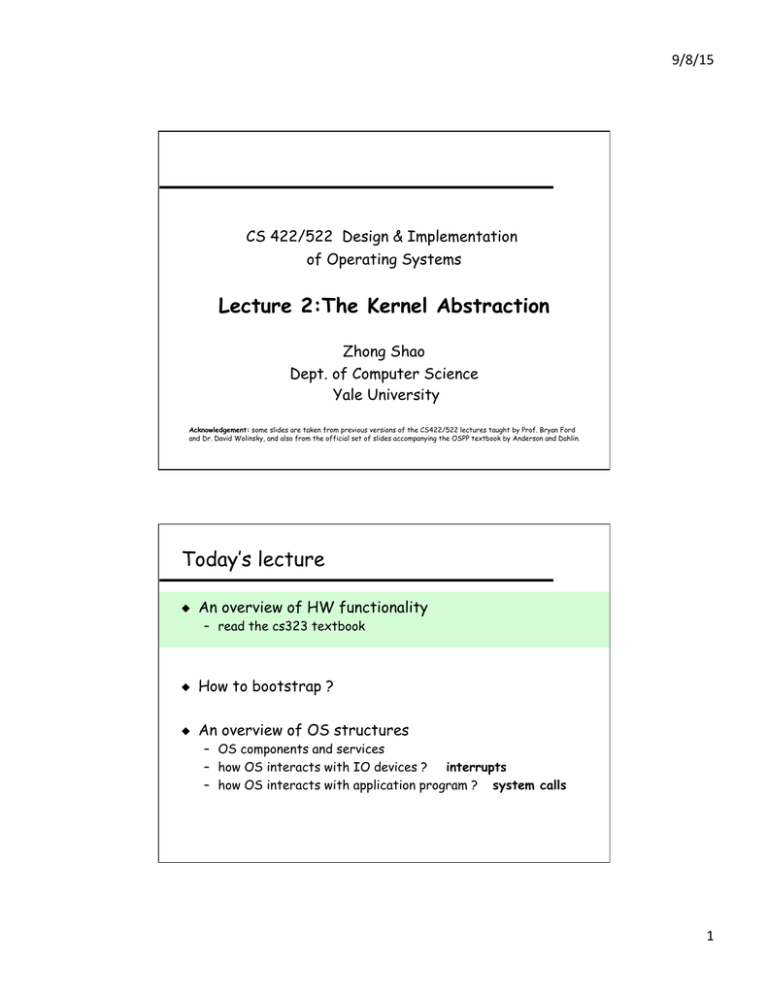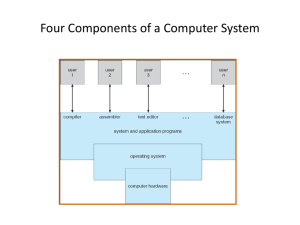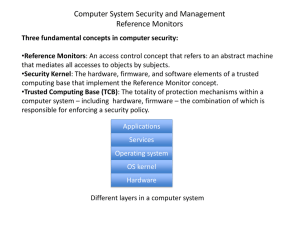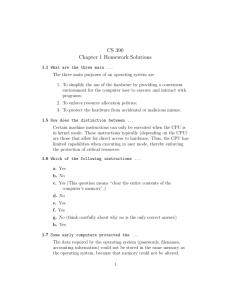Document 10733334
advertisement

9/8/15 CS 422/522 Design & Implementation
of Operating Systems
Lecture 2:The Kernel Abstraction
Zhong Shao
Dept. of Computer Science
Yale University
Acknowledgement: some slides are taken from previous versions of the CS422/522 lectures taught by Prof. Bryan Ford
and Dr. David Wolinsky, and also from the official set of slides accompanying the OSPP textbook by Anderson and Dahlin.
Today’s lecture
◆
An overview of HW functionality
– read the cs323 textbook
◆
How to bootstrap ?
◆
An overview of OS structures
– OS components and services
– how OS interacts with IO devices ? interrupts
– how OS interacts with application program ? system calls
1 9/8/15 What makes a computer system ?
◆
Hardware
– motherboard (cpu, buses, I/O controllers, memory controller, timer);
memory; hard disk & flash drives, CD&DVDROM; keyboard,
mouse; monitor & graphics card; printer, scanner, sound board
& speakers; modem, networking card; case, power supply.
– all connected through buses, cables, and wires
◆
Software
– a bunch of 0/1s; stored on a hard disk or a usb drive or a DVD
* operating system (e.g., Linux, Windows, Mac OS)
* application programs (e.g., gcc, vi)
◆
User (it is “you”)
How a computer becomes alive?
Step 0: connect all HWs together, build the computer
Step 1: power-on and bootstrap
assuming that OS is stored on the boot drive
(e.g., floppy, hard disk, CDROM, or USB)
Step 2: OS takes over and set up all of its services
Step 3: start the window manager and the login prompt
Step 4: user logs in; start the shell; run applications
2 9/8/15 Computer-system architecture
An overview of HW functionality
◆
Executing the machine code (cpu, cache, memory)
– instructions for ALU-, branch-, and memory-operations
– instructions for communicating with I/O devices
◆
Performing I/Os
–
–
–
–
–
–
◆
I/O devices and the CPU can execute concurrently
Each device controller in charge of one device type
Each device controller has a local buffer
CPU moves data btw. main memory and local buffers
I/O is from the device to local buffer of controller
Device controller uses interrupt to inform CPU that it is done
Protection hardware
– timer, paging HW (e.g. TLB), mode bit (e.g., kernel/user)
3 9/8/15 Today’s lecture
◆
An overview of HW functionality
– read the cs323 textbook
◆
How to bootstrap ?
◆
An overview of OS structures
– OS components and services
– how OS interacts with IO devices ? interrupts
– how OS interacts with application program ? system calls
How to bootstrap?
◆
◆
Physical
Memory
Power up a computer
Processor reset
– Set to known state
– Jump to ROM code (for
x86 PC, this is BIOS)
(1)
Disk
Bootloader
◆
◆
◆
◆
Load in the boot loader
from stable storage
Jump to the boot loader
Load the rest of the
operating system
Initialize and run
OS kernel
BIOS copies
bootloader
(2)
BIOS
Bootloader
instructions
and data
Bootloader
copies OS kernel
Login app
(3)
OS kernel
instructions
and data
OS kernel copies
login application
Login app
instructions
and data
4 9/8/15 System boot
◆
◆
Power on (processor waits until Power Good Signal)
Processor jumps on a PC (“Intel Inside”) to address
FFFF0h (Maps to FFFFFFF0h= 232-16)
– 1M = 1,048,576= 220 =FFFFFh+1
– FFFFFh=FFFF0h+16 is the end of the (first 1MB of) system
memory
– The original PC using Intel 8088 had 20 address lines :-)
◆
(FFFFFFF0h) is a JMP instruction to the BIOS startup
program
BIOS startup (1)
◆
POST (Power-On Self-Test)
– If pass then AX:=0; DH:=5 (Pentium);
– Stop booting if fatal errors, and report
◆
◆
Look for video card and execute built-in BIOS code (normally at
C000h)
Look for other devices ROM BIOS code
– IDE/ATA disk ROM BIOS at C8000h (=819,200d)
– SCSI disks may provide their own BIOS
◆
Display startup screen
– BIOS information
◆
Execute more tests
– memory
– system inventory
5 9/8/15 BIOS startup (2)
◆
Look for logical devices
– Label them
* Serial ports: COM 1, 2, 3, 4
* Parallel ports: LPT 1, 2, 3
– Assign each an I/O address and IRQ
◆
Detect and configure PnP devices
◆
Display configuration information on screen
BIOS startup (3)
◆
Search for a drive to BOOT from
– Hard disk or USB drive or CD/DVD
– Boot at cylinder 0, head 0, sector 1
◆
Load code in boot sector
◆
Execute boot loader
◆
Boot loader loads program to be booted
– If no OS: "Non-system disk or disk error - Replace and press
any key when ready"
◆
Transfer control to loaded program
– Which maybe another feature-rich bootloader (e.g., GRUB),
which then loads the actual OS
6 9/8/15 Today’s lecture
◆
An overview of HW functionality
– read the cs323 textbook
◆
How to bootstrap ?
◆
An overview of OS structures
– OS components and services
– how OS interacts with IO devices ? interrupts
– how OS interacts with application program ? system calls
Typical Unix OS structure
Application
Libraries
User level
Kernel level
Portable OS Layer
Machine-dependent layer
7 9/8/15 Typical Unix OS structure
Application
User function calls
written by programmers and
compiled by programmers.
Libraries
Portable OS Layer
Machine-dependent layer
Typical Unix OS structure
Application
• Objects pre-compiled
• Defined in headers
• Input to linker
• Invoked like functions
• May be “resolved”
when program is loaded
Libraries
Portable OS Layer
Machine-dependent layer
8 9/8/15 Pipeline of creating an executable file
foo.c
gcc
foo.s
as
foo.o
bar.c
gcc
bar.s
as
bar.o
libc.a
◆
◆
◆
◆
◆
ld
a.out
…
gcc can compile, assemble, and link together
Compiler part of gcc compiles a program into assembly
Assembler compiles assembly code into relocatable object file
Linker links object files into an executable
For more information:
– Read man page of a.out, elf, ld, and nm
– Read the document of ELF
Execution (run an application)
◆
On Unix, “loader” does the job
–
–
–
–
Read an executable file
Layout the code, data, heap and stack
Dynamically link to shared libraries
Prepare for the OS kernel to run the application
*.o, *.a
ld
a.out
loader
Application
Shared
library
9 9/8/15 What’s an application?
◆
Four segments
Stack
2n -1
– Code/Text – instructions
– Data – initialized global
variables
– Stack
– Heap
◆
Why?
– Separate code and data
– Stack and heap go towards
each other
Heap
Initialized data
Code
0
Responsibilities
◆
Stack
– Layout by compiler
– Allocate/deallocate by process creation (fork) and termination
– Local variables are relative to stack pointer
◆
Heap
– Linker and loader say the starting address
– Allocate/deallocate by library calls such as malloc() and free()
– Application program use the library calls to manage
◆
Global data/code
–
–
–
–
Compiler allocates statically
Compiler emits names and symbolic references
Linker translates references and relocates addresses
Loader finally lays them out in memory
10 9/8/15 Typical Unix OS structure
Application
Libraries
Portable OS Layer
“Guts” of system calls
Machine-dependent layer
OS service examples
◆
Examples that are not provided at user level
– System calls: file open, close, read and write
– Control the CPU so that users won’t stuck by running
* while ( 1 ) ;
– Protection:
* Keep user programs from crashing OS
* Keep user programs from crashing each other
◆
Examples that can be provided at user level
– Read time of the day
– Protected user level stuff
11 9/8/15 Typical Unix OS structure
Application
Libraries
Portable OS Layer
• System initialization
• Interrupt and exception
• I/O device driver
• Memory management
• Mode switching
• Processor management
Machine-dependent layer
OS components
◆
◆
Resource manager for each HW resource
–
–
–
–
processor management (CPU)
memory management
file system and secondary-storage management
I/O device management (keyboards, mouse, …)
–
–
–
–
–
networking
window manager (GUI)
command-line interpreters (e.g., shell)
resource allocation and accounting
protection
Additional services:
* Keep user programs from crashing OS
* Keep user programs from crashing each other
12 9/8/15 Processor management
◆
Goals
– Overlap between I/O and
computation
– Time sharing
– Multiple CPU allocations
◆
CPU
I/O
CPU
CPU
I/O
Issues
– Do not waste CPU resources
– Synchronization and mutual
exclusion
– Fairness and deadlock free
CPU
CPU
CPU
I/O
CPU
CPU
Memory management
Register: 1x
◆
Goals
– Support programs to run
– Allocation and management
– Transfers from and to secondary
storage
◆
Issues
– Efficiency & convenience
– Fairness
– Protection
L1 cache: 2-4x
L2 cache: ~10x
L3 cache: ~50x
DRAM: ~200-500x
Disks: ~30M x
Disks: >1000M x
13 9/8/15 I/O device management
◆
Goals
– Interactions between devices
and applications
– Ability to plug in new devices
◆
Issues
– Efficiency
– Fairness
– Protection and sharing
User 1
...
User n
Library support
Driver
Driver
I/O
device
...
I/O
device
User 1
...
User n
File system
◆
A typical file system
– open a file with
authentication
– read/write data in files
– close a file
File system services
◆
◆
Efficiency and security
Can the services be
moved to user level?
File
...
File
14 9/8/15 Today’s lecture
◆
An overview of HW functionality
– read the cs323 textbook
◆
How to bootstrap ?
◆
An overview of OS structures
– OS components and services
– how OS interacts with IO devices ? interrupts
– how OS interacts with application program ? system calls
Device interrupts
How does an OS kernel communicate with physical devices?
◆
Devices operate asynchronously from the CPU
– Polling: Kernel waits until I/O is done
– Interrupts: Kernel can do other work in the meantime
◆
Device access to memory
– Programmed I/O: CPU reads and writes to device
– Direct memory access (DMA) by device
◆
How do device interrupts work?
–
–
–
–
–
Where does the CPU run after an interrupt?
What is the interrupt handler written in?
What stack does it use?
Is the work the CPU had been doing before the interrupt lost?
If not, how does the CPU know how to resume that work
15 9/8/15 Challenge: protection
◆
How do we execute code with restricted privileges?
– Either because the code is buggy or if it might be malicious
◆
Some examples:
– A user program running on top of an OS
– A third party device driver running within an OS
– A script running in a web browser
– A program you just downloaded off the Internet
– A program you just wrote that you haven’t tested yet
A problem
Physical
Memory
Machine
Instructions
Data
Edits
Source
Code
Compiler
Executable
Image:
Instructions
and Data
Operating
System Copy
Heap
Process
Stack
Machine
Instructions
Data
Heap
Operating
System
Kernel
Stack
16 9/8/15 Main points
◆
Process concept
– A process is the OS abstraction for executing a program with
limited privileges
◆
Dual-mode operation: user vs. kernel
– Kernel-mode: execute with complete privileges
– User-mode: execute with fewer privileges
◆
Safe control transfer
– How do we switch from one mode to the other?
Process abstraction
◆
Process: an instance of a program, running with limited
rights
– Thread: a sequence of instructions within a process
* Potentially many threads per process
– Address space: set of rights of a process
* Memory that the process can access
* Other permissions the process has (e.g., which system calls it can
make, what files it can access)
17 9/8/15 Thought experiment
◆
How can we implement execution with limited
privilege?
–
–
–
–
◆
Execute each program instruction in a simulator
If the instruction is permitted, do the instruction
Otherwise, stop the process
Basic model in Javascript and other interpreted languages
How do we go faster?
– Run the unprivileged code directly on the CPU!
Hardware support: dual-mode operation
◆
Kernel mode
– Execution with the full privileges of the hardware
– Read/write to any memory, access any I/O device, read/write
any disk sector, send/read any packet
◆
User mode
– Limited privileges
– Only those granted by the operating system kernel
◆
◆
On the x86, mode stored in EFLAGS register
On the MIPS, mode in the status register
18 9/8/15 A model of a CPU
Branch Address
New PC
Program
Counter
Select PC
CPU
Instructions
Fetch and
Execute
opcode
A CPU with dual-mode operation
Branch Address
New PC
Handler PC
Program
Counter
Select PC
Select
Mode
CPU
Instructions
Fetch and
Execute
New Mode
Mode
opcode
19 9/8/15 Hardware support: dual-mode operation
◆
Privileged instructions
– Available to kernel
– Not available to user code
◆
Limits on memory accesses
– To prevent user code from overwriting the kernel
◆
Timer
– To regain control from a user program in a loop
◆
Safe way to switch from user mode to kernel mode,
and vice versa
Privileged instruction examples
◆
Memory address mapping
◆
Cache flush or invalidation
◆
Invalidating TLB entries
◆
Loading and reading system registers
◆
Changing processor modes from kernel to user
◆
Changing the voltage and frequency of processor
◆
Halting a processor
◆
I/O operations
What should happen if a user program
attempts to execute a privileged instruction?
20 9/8/15 Virtual addresses
◆
◆
Translation done
in hardware, using
a table
Table set up by
operating system
kernel
Virtual Addresses
(Process Layout)
Physical
Memory
Code
Data
Code
Data
Heap
Heap
Stack
Stack
Hardware timer
◆
Hardware device that periodically interrupts the
processor
– Returns control to the kernel handler
– Interrupt frequency set by the kernel
* Not by user code!
– Interrupts can be temporarily deferred
* Not by user code!
* Interrupt deferral crucial for implementing mutual exclusion
21 9/8/15 “User ⇔ Kernel” model switch
An interrupt or exception or system call (INT)
User mode
Ø Regular instructions
Ø Access user-mode memory
Kernel (privileged) mode
Ø All instructions
Ø Access all memory
A special instruction (IRET)
Mode switch
◆
From user mode to kernel mode
– System calls (aka protected procedure call)
* Request by program for kernel to do some operation on its behalf
* Only limited # of very carefully coded entry points
– Interrupts
* Triggered by timer and I/O devices
– Exceptions
* Triggered by unexpected program behavior
* Or malicious behavior!
22 9/8/15 System calls
◆
◆
◆
User code cannot modify
kernel memory
Makes a system call with
parameters
User
program
The call mechanism
switches code to kernel
mode
◆
Execute system call
◆
Return with results
User
program
urn
ret
◆
User code can be arbitrary
entry
Kernel in
protected memory
They are like “local” remote procedure calls (RPCs)
Interrupts and exceptions
◆
Interrupt sources
– Hardware (by external devices)
– Software: INT n
◆
Exceptions
– Program error: faults, traps, and aborts
– Software generated: INT 3
– Machine-check exceptions
◆
See Intel document volume 3 for details
23 9/8/15 Interrupt and exceptions (1)
Vector #
Mnemonic
Description
Type
0
#DE
Divide error (by zero)
Fault
1
#DB
Debug
Fault/trap
NMI interrupt
Interrupt
2
3
#BP
Breakpoint
Trap
4
#OF
Overflow
Trap
5
#BR
BOUND range exceeded
Trap
6
#UD
Invalid opcode
Fault
7
#NM
Device not available
Fault
8
#DF
Double fault
Abort
Coprocessor segment overrun
Fault
9
10
#TS
Invalid TSS
Interrupt and exceptions (2)
Vector #
Mnemonic
Description
Type
11
#NP
Segment not present
Fault
12
#SS
Stack-segment fault
Fault
13
#GP
General protection
Fault
14
#PF
Page fault
Fault
Reserved
Fault
15
16
#MF
Floating-point error (math fault)
Fault
17
#AC
Alignment check
Fault
18
#MC
Machine check
Abort
19-31
Reserved
32-255
User defined
Interrupt
24 9/8/15 How to take interrupt & syscall safely?
◆
Interrupt & trap & syscall vector
– Limited number of entry points into kernel
◆
Atomic transfer of control
– Single instruction to change:
*
*
*
*
◆
Program counter
Stack pointer
Memory protection
Kernel/user mode
Transparent restartable execution
– For HW interrupts: user program does not know interrupt
occurred
– For system calls: it is just like return from a function call
Interrupt & trap & syscall vector
◆
Table set up by OS kernel; pointers to code to run on
different events
Processor
Register
Interrupt
Vector Table
handleTimerInterrupt() {
...
}
handleDivideByZero() {
...
}
handleSystemCall() {
...
}
25 9/8/15 Interrupt & trap & syscall vector (cont’d)
HW Device
Interrupt
System
Service
dispatcher
System Call
HW exceptions
SW exceptions
Virtual address
exceptions
Interrupt
service
routines
Syscall table
System
services
System
service
dispatcher
Exception
dispatcher
Exception
handlers
VM manager’s
pager
HW implementation of the boundary
Interrupt stack
Per-processor, located in kernel memory. Why can’t the interrupt
handler run on the stack of the interrupted user process?
Running
Ready to Run
Waiting for I/O
Syscall
User Stack
Proc2
Proc2
Proc2
Proc1
Proc1
Proc1
Main
Main
Main
I/O Driver
Top Half
Syscall
Handler
Kernel Stack
User CPU
State
User CPU
State
26 9/8/15 Interrupt handler & interrupt masking
◆
Interrupt handler often non-blocking (with interrupts off),
run to completion (then re-enable interrupts)
– Minimum necessary to allow device to take next interrupt
– Any waiting must be limited duration
– Wake up other threads to do any real work
* Linux: semaphore
◆
Rest of device driver runs as a kernel thread
◆
Interrupt masking: OS kernel can also turn interrupts off
– Eg., when determining the next process/thread to run
– On x86
* CLI: disable interrrupts
* STI: enable interrupts
* Only applies to the current CPU (on a multicore)
Case study: x86 interrupt & syscall
◆
◆
◆
◆
◆
◆
◆
Save current stack pointer
Save current program counter
Save current processor status word (condition codes)
Switch to kernel stack; put SP, PC, PSW on stack
Switch to kernel mode
Vector through interrupt table
Interrupt handler saves registers it might clobber
27 9/8/15 Before interrupt
User-level Process
foo () {
while(...) {
x = x+1;
y = y-2;
}
}
User Stack
Registers
SS: ESP
CS: EIP
Kernel
handler() {
pushad
...
}
EFLAGS
Other Registers:
EAX, EBX,
Interrupt
Stack
During interrupt
User-level Process
foo () {
while(...) {
x = x+1;
y = y-2;
}
}
User Stack
Registers
SS: ESP
CS: EIP
Kernel
handler() {
pushad
...
}
EFLAGS
other registers:
EAX, EBX,
Interrupt
Stack
Error
EIP
CS
EFLAGS
ESP
SS
28 9/8/15 After interrupt
User-level Process
Registers
foo () {
while(...) {
x = x+1;
y = y-2;
}
}
Stack
SS: ESP
CS: EIP
Kernel
handler() {
pushad
...
}
EFLAGS
other registers:
EAX, EBX,
Interrupt
Stack
EBX
EAX
ESP
SS
All
Registers
Error
EIP
CS
EFLAGS
ESP
SS
At end of handler
◆
Handler restores saved registers
◆
Atomically return to interrupted process/thread
– Restore program counter
– Restore program stack
– Restore processor status word/condition codes
– Switch to user mode
29 9/8/15 Kernel system call handler
◆
Locate arguments
– In registers or on user stack
– Translate user addresses into kernel addresses
◆
Copy arguments
– From user memory into kernel memory
– Protect kernel from malicious code evading checks
◆
Validate arguments
– Protect kernel from errors in user code
◆
Copy results back into user memory
– Translate kernel addresses into user addresses
System call stubs
User Program
Kernel
main () {
file_open(arg1, arg2);
}
(1)
file_open(arg1, arg2) {
// do operation
}
(6)
User Stub
(3)
(2)
(4)
Kernel Stub
Hardware Trap
file_open(arg1, arg2) {
push #SYSCALL_OPEN
trap
return
}
Trap Return
(5)
file_open_handler() {
// copy arguments
// from user memory
// check arguments
file_open(arg1, arg2);
// copy return value
// into user memory
return;
}
30 9/8/15 User-level system call stub
// We assume that the caller put the filename onto the stack,
// using the standard calling convention for the x86.
open:
// Put the code for the system call we want into %eax.
movl #SysCallOpen, %eax
// Trap into the kernel.
int #TrapCode
// Return to the caller; the kernel puts the return value in %eax.
ret
Kernel-level system call stub
int KernelStub_Open() {
char *localCopy[MaxFileNameSize + 1];
// Check that the stack pointer is valid and that the arguments are stored at
// valid addresses.
if (!validUserAddressRange(userStackPointer, userStackPointer + size of arguments))
return error_code;
// Fetch pointer to file name from user stack and convert it to a kernel pointer.
filename = VirtualToKernel(userStackPointer);
// Make a local copy of the filename. This prevents the application
// from changing the name surreptitiously.
// The string copy needs to check each address in the string before use to make sure
// it is valid.
// The string copy terminates after it copies MaxFileNameSize to ensure we
// do not overwrite our internal buffer.
if (!VirtualToKernelStringCopy(filename, localCopy, MaxFileNameSize))
return error_code;
// Make sure the local copy of the file name is null terminated.
localCopy[MaxFileNameSize] = 0;
// Check if the user is permitted to access this file.
if (!UserFileAccessPermitted(localCopy, current_process)
return error_code;
// Finally, call the actual routine to open the file.
// handle on success, or an error code on failure.
This returns a file
return Kernel_Open(localCopy);
}
31









